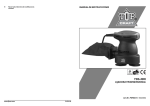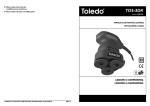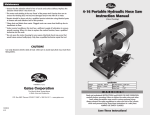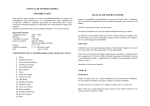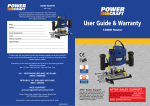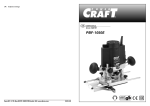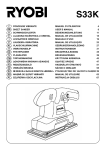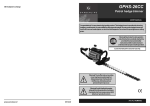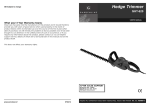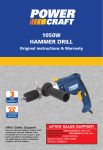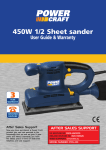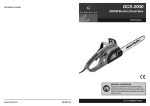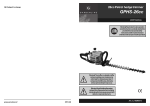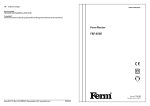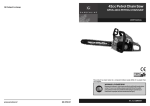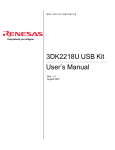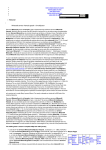Download PDS-3DK
Transcript
UK Subject to change UK USERS MANUAL Art.nr. PSM6014 PDS-3DK Servotool B.V. • P.O. Box 30159 • 8003 CD Zwolle NL 0509-02 EXPLODED VIEW Fig. 1 2 3 1 5 Fig. 2 4 6 2 Powercraft Powercraft 11 UK UK SPARE PARTS LIST PDS-3DK REF NR 800607 800609 800696 800686 806802 408265 408266 408267 408268 PSA1002 PSA1003 PSA1004 PSA1005 408257 DESCRIPTION BEARING 607 Z BEARING 609 ZZ BEARING 696 ZZ BEARING 686 ZZ BEARING 6802 ZZ SANDING DISK ON/OFF SWITCH SWITCH COVER PIN 12-PCS. SET SANDING PAPER RINGS G60 12-PCS. SET SANDING PAPER RINGS G80 12-PCS. SET SANDING PAPER RINGS G100 12-PCS. SET POLISHING WHEELS DUST BAG 3 DIMENSIONAL SANDER (PDS-3DK) POWERCRAFT NR 4 8 11 17 20 21 29 30 31 - For your own safety and for the safety of others, please read these instructions carefully before using this appliance. It will help you understand your product more easily and avoid unnecessary risks. Keep this instruction manual in a safe place for future use. Introduction The 3 Dimensional sander (PDS-3DK) is designated for dry sanding and polishing round, square and flat surfaces. Contents: 1. Machine data 2. Safety instructions 3. Assembly 4. Use 5. Service & maintenance 1. MACHINE DATA Contents of packing • 3 Dimensional sander • Dust bag • Sanding rings: -15 pcs. G60 -15 pcs. G80 -15 pcs. G120 • Polishing wheels (15 pcs.) • User manual • Warranty card Technical specification Voltage Frequency Input power Tool class No load speed Diameter sanding disc Lpa (Sound pressure level) Lwa (Sound power level) Weight Vibration AC 230 V 50 Hz 180 W II 3200 /min 51 mm 65.1 dB(A) 76.1 dB(A) 1,3 kg 1.54 m/s2 Features Fig. 1+2 1. On/off switch 2. Handle 3. Dust bag 4. Sanding disc 5. Ventilating apertures 6. Sanding ring 10 Powercraft Powercraft 3 UK UK Lubrication The appliance does not need any extra lubrication. 2. SAFETY INSTRUCTIONS Explanation of symbols In this manual and/or on the machine the following symbols are used: In accordance with essential applicable safety standards of European directives Faults If a fault arises through wear in an element, please contact the service address shown on the warranty card. A drawing of the spare parts that may be obtained is included at the end of these operating instructions. Environment To prevent damage during transport, the appliance is delivered in a solid packaging which consists largely of reusable material. Therefore please make use of options for recycling the packaging. Class II machine – Double insulation – You don’t need any earthed plug. Risk of damaging material and/or physical injuries Warranty Read the terms of warranty on the separate warranty card which is enclosed. Shows presence of voltage Read the manual CE DECLARATION OF CONFORMITY (UK) Wear a dust mask We declare under our sole responsability that this product is in conformity with the following standards or standardized documents EN50144-1, EN50144-2-3, EN55014-1, EN55014-2, EN61000-3-2, EN61000-3-3 Wear eye and ear protection Old electrical appliances are valuable resources, which is why they do not belong with the household refuse! We would therefore like to ask you to support us through your active contribution to safeguarding resources and protecting the environment by handing in these appliances to the recycling points that have been set up - where these are available. Electrical safety • Always check that the power supply corresponds to the voltage on the rating plate. • Immediately throw away old cables or plugs when they have been replaced by new ones. It is dangerous to insert the plug of a loose cable in the wall outlet. • Only use an approved extension cable suitable for the power input of the machine. The minimum conductor size is 1,5 mm2. When using a cable reel always unwind the reel completely. • Good practice to use an RCD (circuit breaker) Specific safety instructions in accordance with the regulations. 98/37/EEC 73/23/EEC 89/336/EEC from 01-05-2004 ZWOLLE NL W. Kamphof Quality department It is our policy to continuously improve our products and we therefore reserve the right to change the product specification without prior notice. Contact or inhalation of dust coming free during sanding (e.g. lead painted surfaces, woods and metals), can endanger the health of operator and bystanders. Always wear appropriate personal equipment as a dust mask and use the dust bag during sanding. • • 4 Check that the switch is not in the “ON” position before connecting the machine to the mains voltage. Always keep away the mains lead from moving parts of the machine. Powercraft Powercraft 9 UK UK • • Apply long uniform movements to your 3D-Sander to obtain the best possible results. The surface quality after sanding is determined by the selected grain. Use safety glasses, especially when sanding above your head. Coarse sand-paper (grain 60) removes in general the bigger part of the material and fine sand paper (grain 120) is used for the finishing. • POLISHING / WAXING The appliance is equipped with 15 polishing wheels (white felt rings). • • Clean the sander thorough with help of a compressor (air pressure), before you start polishing. Parts of dust (particularly metal parts) which stay behind on the appliance could easily damage the surface of the workpiece. Before you begin to wax or polish your car or boat: • Wash, clean and dry your vehicle. • Remove all road tar, excess grease spots and bug stains. • Make sure the work area is dry. • Do not exert pressure on the surface, do not rock the machine, keep machine level at all times, use only a clean machine and fresh polish wheels. 5. SERVICE & MAINTENANCE • • • • • Solution • Hold the machine correctly. The abrasive paper exhibits a grain size coarser than 60. • The electromotor gets hot Clean the ventilating apertures • The dust is not extracted The dust bag is full / empty the dust bag GENERAL SAFETY RULES The discs come off the machine The discs are worn down. Replace the discs. WARNING! Read all instructions. Failure to follow all instructions listed below may result in electric shock, fire and/or serious injury. The term “power tool” in all of the warnings listed below refers to your mains operated (corded) power tool or battery operated (cordless) power tool. The abrasive paper is filled with adhesive/paint or a similar material Paint or adhesive is not really dry. Some paints stick more to the abrasive paper than others / clean the abrasive paper at regular intervals Cleaning Remove plug before cleaning Clean the housing regularly with a soft cloth, preferably every time it is used. Keep the ventilating apertures free from dust and dirt. Blow dust away from ventilation holes. Remove stubborn dirt with a soft rag moistened in soapy water. Do not use any solvents such as petrol, alcohol, ammonia, etc. as such substances can damage the plastic parts. When cleaning with a cloth use a slightly damp, not wet cloth. Make sure that the machine is completely dry before use. 8 • • • • Troubleshooting Problem The machine ‘jerks’; it cannot be controlled properly • Check that speed marked on the wheel is equal to or greater than the rated speed of the grinder. Ensure that the wheel dimensions are compatible with the grinder. Abrasive wheels shall be stored and handled with care in accordance with manufacturer's instructions. Inspect the grinding wheel before use, do not use chipped, cracked or otherwise defective products. Ensure that mounted wheels and points are fitted in accordance with the manufacturer's instructions. Ensure that blotters are used when they are provided with the bonded abrasive product and when they are required. Ensure that the abrasive product is correctly mounted and tightened before use and run the tool at no-load for 30 s in a safe position, stop immediately if there is considerable vibration or if other defects are detected. If this condition occurs, check the machine to determine the cause. If a guard is supplied with the tool never use the tool without such a guard. Do not use separate reducing bushings or adapters to adapt large hole abrasive wheels. For tools intended to be fitted with threaded hole wheel, ensure that the thread in the wheel is long enough to accept the spindle length. Check that the work piece is properly supported. Do not use cutting off wheel for side grinding. Ensure that sparks resulting from use do not create a hazard e.g. do not hit persons, or ignite flammable substances. Ensure that ventilation openings are kept clear when working in dusty conditions. If it should become necessary to clear dust, first disconnect the tool from the mains supply (use non metallic objects) and avoid damaging internal parts. Always use eye and ear protection. Other personal protective equipment such as dust mask, gloves, helmet and apron should be worn. The wheel continues to rotate after the tool is switched off. Powercraft SAVE THESE INSTRUCTIONS 1) Work area a. Keep work area clean and well lit. Cluttered and dark areas invite accidents. b. Do not operate power tools in explosive atmospheres, such as in the presence of flammable liquids, gasses or dust. Power tools create sparks which may ignite the dust of fumes. c. Keep children and bystanders away while operating a power tool. Distractions can cause you to lose control. 2) Electrical safety a. Power tool plugs must match the outlet. Never modify the plug in any way. Do not use any adapter plugs which earthed (grounded) power tools. Unmodified plugs and matching outlets will reduce risk of electric shock. b. Avoid body contact with earthed or grounded surfaces such as pipes, radiators, ranges and refrigerators. There is an increased risk of electric shock if your body is earthed or grounded. c. Do not expose power tools to rain or wet conditions. Water entering a power tool will increase the Powercraft 5 UK UK d. e. risk of electric shock. Do not abuse the cord. Never use the cord for carrying, pulling or unplugging the power tool. Keep cord away from heat, oil, sharp edges or moving parts. Damaged or entangled cords increase the risk of electric shock. When operating a power tool outdoors, use an extension cord suitable for outdoor use. Use of a cord suitable for outdoor use reduces the risk of electric shock. Always use tool in conjunction with a residual circuit breaker device. 3) Personal safety a. Stay alert, watch what you are doing and use common sense when operating a power tool. Do not use a power tool while you are tired or under the influence of drugs, alcohol or medication. A moment of inattention while operating power tools may result in serious personal injury. b. Use safety equipment. Always wear eye protection. Safety equipment such as dust mask, nonskid safety shoes, hard hat, or hearing protection used for appropriate conditions will reduce personal injuries. c. Avoid accidental starting. Ensure the switch is in the off position before plugging in. Carrying power tools with your finger on the switch or plugging in power tools that have the switch on invites accidents. d. Remove any adjusting key or wrench before turning the power tool on. A wrench or a key left attached to a rotating part of the power tool may result in personal injury. e. Do not overreach. Keep proper footing and balance at all times. This enables better control of the power tool in unexpected situations. f. Dress properly. Do not wear loose clothing or jewellery. Keep your hair, clothing and gloves away from moving parts. Loose clothes, jewellery or long hair can be caught in moving parts. g. If devices are provided for the connection of dust extraction and collection facilities, ensure these are connected and properly used. Use of these devices can reduce dust related hazards. h. Use clamps or a vice to hold work. It’s safer than using your hand and it frees both hands to operate tool. 4) Power tool use and care a. Do not force the power tool. Use the correct power tool for your application. The correct power tool will do the job better and safer at the rate for which it was designed. b. Do not use the power tool if the switch does not turn it on and off. Any power tool that cannot be controlled with the switch is dangerous and must be repaired. c. Disconnect the plug from the power source before making any adjustments, changing accessories, or storing power tools. Such preventive safety measures reduce the risk of starting the power tool accidentally. d. Store idle power tools out of the reach of children and do not allow persons unfamiliar with the power tool or these instructions to operate the power tool. Power tools are dangerous in the hands of untrained users. e. Maintain power tools. Check for misalignment or binding of moving parts, breakage of parts and any other condition that may affect the power tools operation. If damaged, have the power tool repaired before use. Many accidents are caused by poorly maintained power tools. f. Keep cutting tools sharp and clean. Properly maintained cutting tools with sharp cutting edges are less likely to bind and are easier to control. g. Use the power tool, accessories and tool bits etc., in accordance with these instructions and in the manner intended for the particular type of power tool, taking into account the working conditions and the work to be performed. Use of the power tool for operations different from intended could result in hazardous situation. 5) Service a. Have your power tool serviced by a qualified repair person using only identical replacement parts. This will insure that the safety of the power tool is maintained. 3. ASSEMBLY Dust collection Fig. 1 The 3D sander has been carried out with a dust bag (3) to keep the working surface clean. The dust bag must be installed on the rear of the machine, on the opening. It is necessary to empty the dust bag regularly for an efficient use. Empty it as follows: • Turn the dust bag slightly and pull it out of the machine’s adapter. • Empty the dust bag in a suitable place. • Push the dust bag on to the machine’s adapter till it locks into place. Replacing a disc Fig. 2 • Simply hold the discs (4) between your thumb and forefinger and pull • Insert new discs Replacing worn sanding rings Fig. 2 The sanding rings (6) are fixed by Velcro fasteners to facilitate their replacement. • Simply pull off the sanding ring • Press the new one in the centre of the disc (4) 4. USE Operation Fig.1 Hold the sander on the handle (2), so as to gain the best possible control over your sanding operations. • The ventilating apertures (5) on the housing must remain clear to ensure optimum cooling of the motor. • Push the on/off switch (1) to start the machine. • Move the 3D sander over the surface of your workpiece. • Push the on/off switch to stop the machine. Warning: 1) Prevent pushing too much on the machine during sanding. Excessive sanding pressure does not lead to increased sanding capacity, but increases wear of the machine and the sanding rings. 2) The 3 Dimensional sander is only suitable for workpieces who are at least as big as the dimension of the sander. 3) A sanding ring which is used for sanding metal workpieces, should not be used for other materials. 4) Sanding rings which are worn or torn can damage the workpiece. Replace the sanding rings regularly. User tips • Thanks to three rotating, independently-contouring heads flat, concave and also convex surfaces can be sandedsuch as a boat, car body work and round pieces of furniture. 6 Powercraft Powercraft 7






